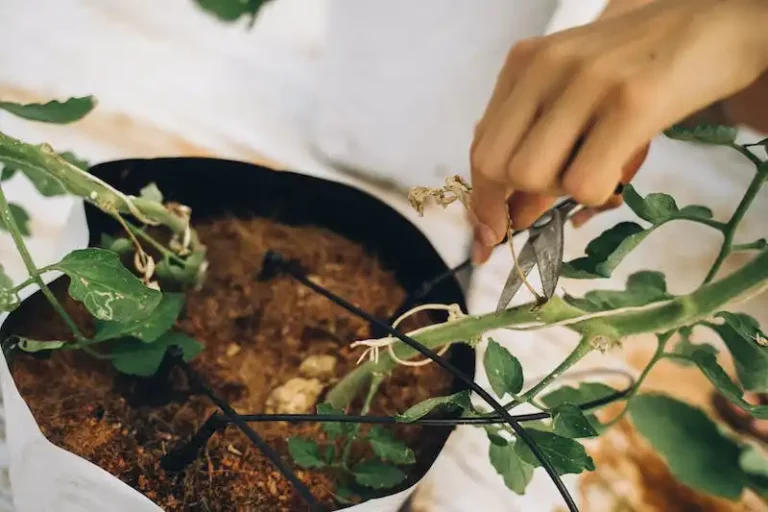Growing red currants is not something new or trendy. On the contrary, it is a tradition as old as time itself. Red currant bushes can be seen in many old gardens, beautifully placed among the other fruit trees. But how to grow these delicious berries yourself?
If you want to grow red currants, you need to start by choosing the right spot. Red currant bushes prefer a sunny location, although they can tolerate some shade. They also like to be sheltered from strong winds, so planting them near a fence or an old bamboo trellis is a good idea.
The soil should be well-rotted and rich in organic matter. Red currants, like most currant varieties, don’t like their roots to be constantly wet, so good drainage is important. Before planting the currant bushes, prepare the soil by digging a hole about twice the size of the root ball and incorporating some well-rotted compost or manure.
When planting the red currant bush, make sure to space them well, about 1.2-1.5 meters apart. Red currants have a tendency to grow into beautiful, bushy plants with many shoots – called canes. These canes should not touch each other, as this can cause the spread of diseases. It is also a good idea to keep some space between the currant bushes and other plants, to ensure good air circulation.
PLANT GROW PRUNE REDCURRANTS
Growing red currants requires proper care and attention. Follow these instructions to ensure a bountiful harvest of delicious currants.
Planting: Choose a sunny location with well-drained soil for the redcurrant bush. Dig a hole deep enough to accommodate the root ball and twice as wide. Place the plant in the hole, making sure the base of the stem is level with the soil surface. Fill the hole with soil, firming it gently around the roots. Water thoroughly.
Support: Redcurrant bushes tend to grow tall and bushy. Therefore, it is essential to provide them with proper support. Use a stake or trellis system to keep the plant upright and prevent the branches from bending and breaking under the weight of the fruit clusters.
Pruning: Pruning redcurrants should be done during late winter or early spring while the plant is dormant. Remove any dead or damaged wood, as well as any crossing branches. Thin out the center of the bush to improve air circulation and reduce the risk of diseases. Prune back one-third of the oldest stems to the base to encourage new growth and keep the plant productive.
Pests and Diseases: Redcurrants can sometimes be attacked by aphids. Monitor the plants regularly and take action by using organic pest control methods if necessary. Applying a layer of mulch around the base of the plant can help prevent weed formation and reduce the risk of pest attacks.
Harvesting: Redcurrants are ready to be harvested when they are fully ripe and show a bright red color. Gently twist the fruit clusters to easily detach them from the stem. Harvest each cluster individually as they ripen at different times.
By following these instructions, you will be able to grow, prune, and care for redcurrant bushes like a professional. Enjoy the delicious and nutritious fruit they will produce!
WHERE TO GROW REDCURRANTS
If you want to grow delicious redcurrants, it is important to choose the right location for planting. Redcurrants thrive in a sunny spot, but can also tolerate some shade. They prefer a well-drained soil that is rich in organic matter, so make sure to prepare the soil before planting by removing any weeds and adding compost or well-rotted manure.
Redcurrants can be grown as individual bushes or trained against a wall or fence as cordons. If you choose to grow them as bushes, keep in mind that they can grow quite large, reaching up to 5 feet in height and width. Therefore, it is important to leave enough space between the plants to allow for their full growth.
When planting redcurrants, dig a hole that is wide and deep enough to accommodate the roots of the plant. Place the plant in the hole, making sure that the soil level is the same as it was in the nursery or pot. Gently firm the soil around the roots, ensuring that the plant is stable and upright. Water the plant thoroughly after planting to help settle the soil.
Redcurrants are best planted in the spring, preferably after the danger of frost has passed. This will give the plants enough time to establish their root system before the summer months when they will produce their berries. However, they can also be planted in the autumn if necessary.
Once your redcurrants are planted, they will need regular care and attention to ensure optimal growth and fruit production. Prune the plants in late winter or early spring to remove any dead, diseased, or damaged wood. Also, remove any overcrowded branches to improve air circulation and prevent disease. Pruning is also important for the formation of fruiting clusters, as redcurrants produce berries on the previous year’s growth.
To promote maximum fruit production, redcurrants should be watered regularly, especially during dry periods. Mulching around the plants with organic matter, such as compost or straw, will help to retain moisture and suppress weeds. Redcurrants are also heavy feeders, so it is beneficial to apply a balanced fertilizer in the spring.
In terms of diseases and pests, redcurrants can be prone to powdery mildew and currant aphids. To prevent these problems, make sure to plant your redcurrants in an open and well-ventilated area. Also, keep the plants well-watered and avoid over-fertilizing, as this can make them more susceptible to disease. If necessary, you can use organic sprays or insecticidal soap to control pests.
When it comes to harvesting your redcurrants, it is important to pick the berries at the right time. Redcurrants are ready to be harvested when they are fully ripe and easily come off the plant when lightly touched. The berries should be firm and juicy, with a bright red color. It is best to pick the berries in the morning when they are cool and before the sun causes them to become too soft.
In conclusion, growing redcurrants can be a rewarding experience, as they are not only delicious but also combine many health benefits. By following the instructions above and providing your redcurrants with the right conditions and care, you’ll be able to enjoy a bountiful harvest of these tasty berries.
WHERE TO BUY REDCURRANT BUSHES IN THE UK
For our regular readers who are keen gardeners, finding a good source of redcurrant bushes is essential to ensure a successful growing experience. The quality of the rootstock and the berry bushes themselves can make all the difference in the health and productivity of your plants.
When choosing where to buy your redcurrant bushes, it’s important to consider the risks of pests and diseases that can attack currant bushes. Aphids are a common problem for currants, both redcurrants and blackcurrants, and whitecurrants are not exempt either. Therefore, choosing a reliable source that has applied proper pest control measures is crucial.
One option is to buy redcurrant bushes from a local nursery or garden center. This way, you can see the plants in person and ensure they are healthy before bringing them home. Additionally, staff at these establishments are often knowledgeable and can provide advice on how to care for your plants and protect them from pests and diseases.
If you prefer the convenience of online shopping, there are several reputable websites that sell redcurrant bushes. Look for websites that have positive reviews and guarantee the quality of their plants. Reading customer comments can also give you valuable insights into the experiences of other gardeners who have purchased from the site.
It’s important to note that redcurrant bushes can also be propagated from cuttings. This is a great option if you want to rescue an old bush or if you want to grow multiple plants at a lower cost. Layering is another propagation method that can be used to grow redcurrant bushes from an existing plant.
Whether you choose to buy from a nursery, garden center, or online retailer, make sure to consider the specific variety of redcurrant bush you want to grow. Different varieties have different qualities, such as taste, size, and resistance to pests and diseases. Additionally, ensure that the chosen source offers guidance on how to properly plant and care for the bushes, such as correct pruning techniques and fertilizer recommendations.
With the right redcurrant bushes and proper care, you can enjoy delicious redcurrants straight from your own garden. Good luck with your growing journey!
WHEN AND HOW TO PLANT REDCURRANTS
Redcurrants are primarily grown in the UK and are mainly propagated through cuttings. Ribes plants, which include redcurrants, can be grown as bushes, cordons, or standards. To get the best crops, it is important to follow the standard instructions for planting and caring for redcurrants.
Redcurrants should be planted in well-drained soil during the late autumn or early spring. Before planting, make sure the soil has been worked and is free from weeds. Dig a hole for each redcurrant plant, ensuring that it is large enough to accommodate the roots. The hole should be around 30cm deep and wide enough to fit the roots comfortably.
When planting redcurrants, it is important to keep the regular formation of the plant in mind. Prune any damaged or dead stems and trim the ones that are too long. This will help maintain the shape and overall health of the plant. Smart gardeners also suggest keeping the canes shorter to make it easier to pick the redcurrants later on.
Once the redcurrant plant is in place, it must be watered thoroughly to ensure it receives enough moisture. Redcurrants can grow in both sunny and partially shaded areas, but they tend to prefer open spaces with plenty of sunlight. For better air circulation and to avoid diseases like mildew or blister, it is recommended to plant redcurrants in an open location.
Redcurrants can be grown as individual bushes or trained as cordons, which are long stems that are left unpruned but trained to grow in a particular direction. Cordons can be placed against a wall or fence to save space in the garden. Alternatively, redcurrants can be grown as standard trees with a central stem and a crown of branches.
One of the qualities of redcurrants is that they are less prone to greenfly attack compared to other berries. However, gardeners recommend regularly checking for pests and taking appropriate action if needed.
Redcurrants are typically ready for harvesting in the summer, around June or July. The berries should be picked when they are fully ripe, which can be determined by their red color. Redcurrants can be eaten fresh or used in various culinary preparations like jams, jellies, and desserts.
If you are new to growing redcurrants, there are many online guides and video tutorials that offer step-by-step instructions to help you get started. By following these guidelines and tips, you can grow your own delicious redcurrants and enjoy their beautiful berries for years to come.
Sign up to our page to receive three-year-old redcurrant plants and tips on how to care for them. You can also check out our comments section for feedback from other gardeners who have successfully grown redcurrants. Don’t hesitate to ask questions or share your own experiences!
Remember, redcurrants can be a delicious addition to your garden, and with proper planting and care, they can thrive and provide a bountiful harvest for you to enjoy!




